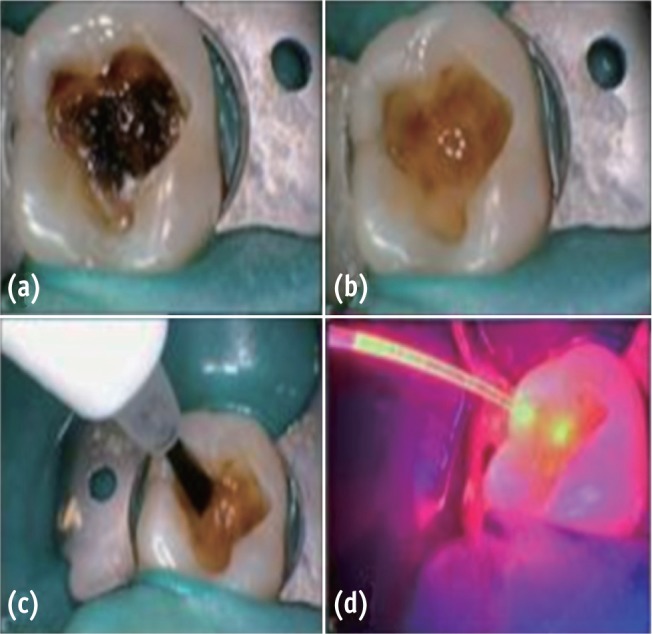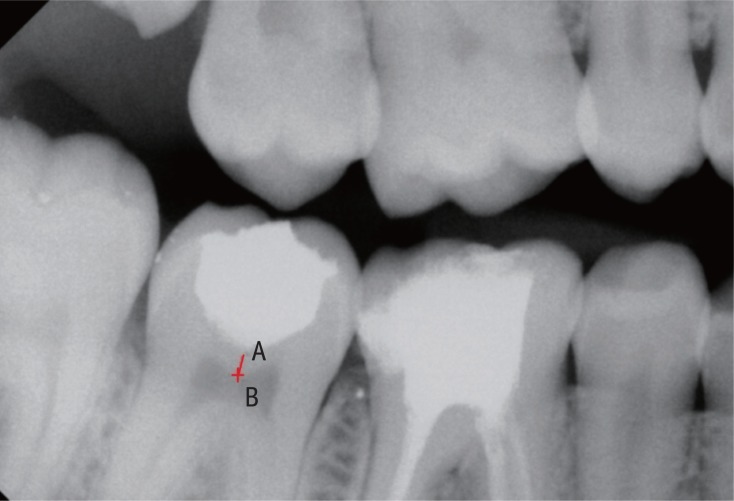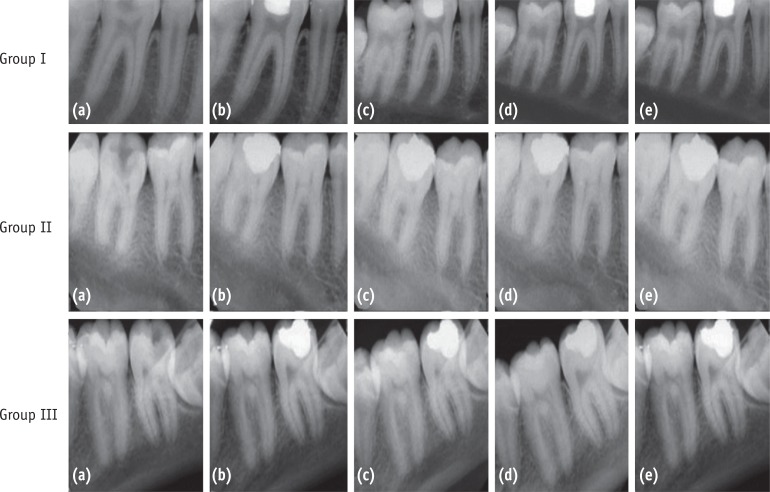Restor Dent Endod.
2014 Aug;39(3):195-200.
Comparative efficacy of photo-activated disinfection and calcium hydroxide for disinfection of remaining carious dentin in deep cavities: a clinical study
- Affiliations
-
- 1Department of Conservative Dentistry and Endodontics, Centre for Dental Education and Research, All India Institute of Medical Sciences, Ansari nagar, New Delhi, India. apexlogani@yahoo.co.in
Abstract
OBJECTIVES
To comparatively evaluate the efficacy of photo-activated disinfection (PAD), calcium hydroxide (CH) and their combination on the treatment outcome of indirect pulp treatment (IPT).
MATERIALS AND METHODS
Institutional ethical clearance and informed consent of the patients were taken. The study was also registered with clinical registry of India. Sixty permanent molars exhibiting deep occlusal carious lesion in patients with the age range of 18 - 22 yr were included. Clinical and radiographic evaluation and set inclusion and exclusion criteria's were followed. Gross caries excavation was accomplished. In group I (n = 20) PAD was applied for sixty seconds. In group II (n = 20), CH was applied to the remaining carious dentin, while in group III (n = 20), PAD application was followed by CH placement. The teeth were permanently restored. They were clinically and radiographically followed-up at 45 day, 6 mon and 12 mon. Relative density of the remaining affected dentin was measured by 'Radiovisiography (RVG) densitometric' analysis.
RESULTS
Successful outcome with an increase in radiographic grey values were observed in all three groups. However, on inter-group comparison, this change was not significant (p > 0.05).
CONCLUSIONS
PAD and CH both have equal disinfection efficacy in the treatment of deep carious dentin. PAD alone is as effective for treatment of deep carious lesion as calcium hydroxide and hence can be used as an alternative to CH. They can be used independently in IPT, since combining both does not offer any additional therapeutic benefits.
Keyword
MeSH Terms
Figure
Reference
-
1. Ingle JI, Bakland LK. Endodontics. 6th ed. London: DC Becker Inc;2008. p. 1310–1312.2. Fusayama T, Okuse K, Hosoda H. Relationship between hardness, discoloration, and microbial invasion in carious dentin. J Dent Res. 1966; 45:1033–1046. PMID: 5224073.
Article3. Fagundes TC, Barata TJ, Prakki A, Bresciani E, Pereira JC. Indirect pulp treatment in a permanent molar: case report of 4-year follow-up. J Appl Oral Sci. 2009; 17:70–74. PMID: 19148410.4. Eidelman E, Finn SB, Koulourides T. Remineralization of carious dentin treated with calcium hydroxide. J Dent Child. 1965; 32:218–225. PMID: 5318013.5. Pinto AS, de Araújo FB, Franzon R, Figueiredo MC, Henz S, García-Godoy F, Maltz M. Clinical and microbiological effect of calcium hydroxide protection in indirect pulp capping in primary teeth. Am J Dent. 2006; 19:382–386. PMID: 17212082.6. Burns T, Wilson M, Pearson GJ. Sensitisation of cariogenic bacteria to killing by light from helium-neon laser. J Med Microbiol. 1993; 38:401–405. PMID: 8510132.7. Williams JA, Pearson GJ, Colles MJ, Wilson M. The effect of variable energy input from a novel light source on the photo-activated bactericidal action of toluidine blue O on Streptococcus mutans. Caries Res. 2003; 37:190–193. PMID: 12740542.8. Gruythuysen RJ, van Strijp AJ, Wu MK. Long-term survival of indirect pulp treatment performed in primary and permanent teeth with clinically diagnosed deep carious lesions. J Endod. 2010; 36:1490–1493. PMID: 20728715.
Article9. Orhan AI, Oz FT, Orhan K. Pulp exposure occurrence and outcomes after 1- or 2-visit indirect pulp therapy vs complete caries removal in primary and permanent molars. Pediatr Dent. 2010; 32:347–355. PMID: 20836956.10. Al-Zayer MA, Straffon LH, Feigal RJ, Welch KB. Indirect pulp treatment of primary posterior teeth: a retrospective study. Pediatr Dent. 2003; 25:29–36. PMID: 12627699.11. Bjørndal L, Larsen T, Thylstrup A. A clinical and microbiological study of deep carious lesions during stepwise excavation using long treatment intervals. Caries Res. 1997; 31:411–417. PMID: 9353579.
Article12. Evidence-based review of clinical studies on indirect pulp capping. J Endod. 2009; 35:1147–1151. Edited by Gutmann JL, Solomon E. PMID: 19631852.13. Park YS, Bae KH, Chang J, Shon WJ. Theory of X-ray microcomputed tomography in dental research: application for the caries research. J Korean Acad Conserv Dent. 2011; 36:98–107.
Article14. Di Alberti L, Donnini F, Di Alberti C, Camerino M. A comparative study of bone densitometry during osseointegration: piezo-electric surgery versus rotary protocols. Quintessence Int. 2010; 41:639–644. PMID: 20657852.15. Radionov D, Lulic-Dukić L, Gasparac I. Osseointegration of a replanted tooth followed by RVG densitometry. Coll Antropol. 1998; 22(Suppl):161–166. PMID: 9951158.16. Franzon R, Casagrande L, Pinto AS, García-Godoy F, Maltz M, de Araujo FB. Clinical and radiographic evaluation of indirect pulp treatment in primary molars: 36 months follow-up. Am J Dent. 2007; 20:189–192. PMID: 17672262.17. Franzon R, Gomes M, Pitoni CM, Bergmann CP, Araujo FB. Dentin rehardening after indirect pulp treatment in primary teeth. J Dent Child (Chic). 2009; 76:223–228. PMID: 19941765.18. Soukos NS, Goodson JM. Photodynamic therapy in the control of oral biofilms. Periodontol 2000. 2011; 55:143–166. PMID: 21134233.
Article19. Soukos NS, Ximenez-Fyvie LA, Hamblin MR, Socransky SS, Hasan T. Targeted antimicrobial photochemotherapy. Antimicrob Agents Chemother. 1998; 42:2595–2601. PMID: 9756761.
Article20. Wilson M, Burns T, Pratten J, Pearson GJ. Bacteria in supra-gingival plaque samples can be killed by low-power laser light in the presence of a photosensitizer. J Appl Bacteriol. 1995; 78:569–574. PMID: 7759386.
Article21. Wood S, Nattress B, Kirkham J, Shore R, Brookes S, Griffiths J, Robinson C. An in vitro study of the use of photodynamic therapy for the treatment of natural oral plaque biofilms formed in vivo. J Photochem Photobiol B. 1999; 50:1–7. PMID: 10443029.22. Giusti JS, Santos-Pinto L, Pizzolito AC, Helmerson K, Carvalho-Filho E, Kurachi C, Bagnato VS. Antimicrobial photodynamic action on dentin using a light-emitting diode light source. Photomed Laser Surg. 2008; 26:281–287. PMID: 18637719.
Article23. Williams JA, Pearson GJ, Colles MJ, Wilson M. The photo-activated antibacterial action of toluidine blue O in a collagen matrix and in carious dentin. Caries Res. 2004; 38:530–536. PMID: 15528907.24. Nagata JY, Hioka N, Kimura E, Batistela VR, Terada RS, Graciano AX, Baesso ML, Hayacibara MF. Antibacterial photodynamic therapy for dental caries: evaluation of the photosensitizers used and light source properties. Photodiagnosis Photodyn Ther. 2012; 9:122–131. PMID: 22594982.
Article25. Nammour S, Zeinoun T, Bogaerts I, Lamy M, Geerts SO, Bou Saba S, Lamard L, Peremans A, Limme M. Evaluation of dental pulp temperature rise during photo-activated decontamination (PAD) of caries: an in vitro study. Lasers Med Sci. 2010; 25:651–654. PMID: 19488675.
- Full Text Links
- Actions
-
Cited
- CITED
-
- Close
- Share
- Similar articles
-
- Effect of calcium hydroxide application time on dentin
- Review of Disinfection and Sterilization – Back to the Basics
- The efficacy of chemo-mechanical removal of dentin carious lesion
- Effect of calcium hydroxide on bond strength of dentin bonding systems
- Nurse's Knowledge, Attitude and Practice of Skin Disinfection




